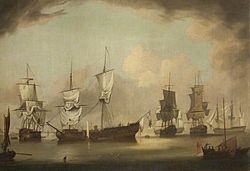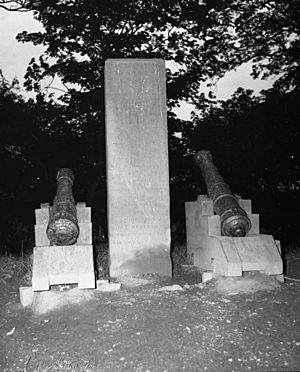Battle of Bishops Court facts for kids
Quick facts for kids Battle of Bishops Court |
|||||||
|---|---|---|---|---|---|---|---|
| Part of the Seven Years' War | |||||||
 The Gallant Action off the Isle of Man where the brave Capt. Elliott defeated Thurot 28th of Feb 1760 by James Macgowan and William Davies. |
|||||||
|
|||||||
| Belligerents | |||||||
| Commanders and leaders | |||||||
| John Elliot | François Thurot † | ||||||
| Strength | |||||||
| 3 frigates | 3 frigates | ||||||
| Casualties and losses | |||||||
| 40 casualties | 3 ships captured 300 killed or wounded 1,000 captured |
||||||
The Battle of Bishops Court, also known as The Defeat of Thurot, was a sea battle that happened on February 28, 1760. It was part of the Seven Years' War. This fight was between three ships from Britain and three ships from France.
The French ships were led by a famous commander named François Thurot. The battle took place in the Irish sea, between the Isle of Man and the coast of Ireland. It started around 9 AM. After a tough fight, Thurot's ships were badly damaged. Their masts were broken, and they were close to sinking. Thurot himself died during the battle. The British won completely, capturing all three French ships.
Contents
Why the Battle Happened
Between February 21 and 26, 1760, a French force arrived near Ireland. This group was led by François Thurot, who was a Privateer. A privateer was like a pirate, but they had permission from their government to attack enemy ships.
Thurot's force had three ships: the Maréchal de Belle-Isle, Terpsichore, and Blonde. They landed 600 French soldiers. These soldiers quickly took over the small group of defenders at Carrickfergus in Ireland. They also captured its castle. Thurot held the town for five days. But many local soldiers, called militia, gathered to fight him. Also, British navy ships appeared nearby. So, Thurot and his men got back on their ships and left the town.
British Ships Respond
The British knew where Thurot was heading. The port of Liverpool had already made its defenses stronger. More ships from the Royal Navy were sent from Portsmouth and Plymouth.
In January, two extra British frigates were sent to the Irish Sea. These were HMS Pallas and HMS Brilliant. They were at the port of Kinsale. On February 24, they heard the alarm about Thurot. They quickly set sail with HMS Æolus. Captain John Elliott was in charge of this group of ships. They passed Dublin on February 26. But bad weather stopped them from entering Belfast Lough that evening. Thurot used this chance to escape.
The Battle Begins
On the night of February 27–28, the British ships sailed south-east. They thought Thurot might attack Whitehaven in Cumberland. Near the Mull of Galloway in southern Scotland, they saw the three French ships. The French ships were anchored at the entrance of Luce Bay.
To avoid being trapped, Thurot's ships quickly sailed south-east. They headed towards the Isle of Man. Captain Elliot, on the Æolus, was leading the British ships. He caught up with the Maréchal de Belle-Isle around sunrise. The battle started, with the Mull of Galloway and Jurby Head (on the Isle of Man) in sight.
Fighting at Sea
After the first round of cannon fire, called a broadside, Thurot tried to get close to the Æolus. He wanted his soldiers to board the British ship. But instead, his ship lost its bowsprit (a large pole at the front). Many of his men on deck were hit by British small-arms fire.
The Æolus fired a second broadside. Then, it cleverly moved back. This allowed the other two British ships to also fire at the Belle-Isle. The Æolus then continued fighting. Captain Thurot, even after losing one arm, bravely refused to give up. When told that water was rushing into his ship, he said, Never mind it, go on. Soon after, he was hit by a grape shot (a type of cannonball) and died.
Lieutenant Forbes of the Æolus saw that the Belle-Isle's deck had few men left. Most of the remaining French sailors were below deck and confused. So, Forbes jumped onto the Belle-Isle with about 25 British sailors and marines. He quickly took down the French flag, which meant the ship had surrendered.
Meanwhile, the Pallas and Brilliant went after the other French ships. The Terpsichore tried to get away but was easily caught and captured by the Pallas. Then, the Brilliant caught and captured the Blonde, which had 400 men. Thurot's body was thrown overboard during the fight. But it was later found and brought ashore by the British. With this last capture, Captain Elliot had won a complete victory.
What Happened Next

The French lost all three of their frigates. They also had many casualties, with 300 killed or wounded. Another 1,000 French soldiers and sailors were captured. There were so many prisoners that Captain Elliot had to use a special ship to take them to Carrickfergus.
The British had very few casualties. The Aeolus had 4 killed and 15 wounded. The Pallas had 1 killed and 5 wounded. The Brilliant had 11 wounded. Elliot took 30 French officers to Plymouth. The other French prisoners were taken to Ramsey, then to Belfast. They arrived there on March 2. On May 10, they were set free and sent back to France.
The three British captains were thanked by the Irish House of Commons. The captured French ships, Blonde and Terpsichore, were bought by the Royal Navy.
Remembering the Battle
Thurot was buried with full honors in the churchyard of Kirkmaiden. A local lord, Sir William Maxwell, paid for the funeral and was the main mourner.
An artist named Richard Wright saw the battle. He painted pictures showing the fight and what happened after. These paintings were later made into engravings. Songs were written about the battle. A book about Thurot was published in June.
A memorial to the battle was built in the grounds of Bishopscourt, Isle of Man. It was called Mount Æolus. It had two cannons and the bowsprit of the Belle-Isle, which had washed ashore. The wooden bowsprit was later replaced by a stone pillar with writing on it.


